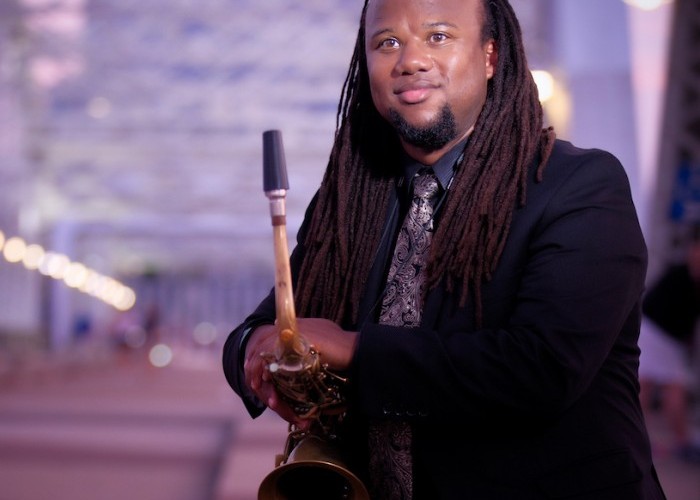Apr 2, 2024 12:59 PM
Saxophonist, Sonic Explorer Casey Benjamin Dies at 45
Casey Benjamin, the alto saxophonist, vocalist, keyboardist and producer who stamped his distinctive sounds on the…

Saxophonist Rahsaan Barber’s new album is titled The Music In The Night.
(Photo: Rod McGaha)Not long ago, Rahsaan Barber was talking with some friends about his new album of standards, The Music In The Night. One of them asked: “Does the world really need another recording of ‘The Girl From Ipanema?’”
“I got a little miffed,” the saxophonist recalled. “So when these people came to one of my gigs, I played ‘Ipanema.’ Then aerwards I said to them, ‘Well, now I’ll ask you: Does the world need another recording of this?’ And everybody was like, ‘Yeah.’”
Other than proving again that music usually speaks more eloquently than words, this exchange also says a lot about how standards are—and ought to be—perceived. On the one hand, it’s easy to play through well-known tunes more or less on autopilot. A more fruitful strategy is to accept that familiarity as a challenge, to engage with the material in ways that are unique to who you are.
That was Barber’s mission with The Music In The Night, released on his Jazz Music City label. You could say he’s been gearing up for it since childhood, when he first heard Billie Holiday’s rendition of “Georgia On My Mind.”
“I’d grown up thinking that Ray Charles was that tune,” he said. “But her recording made it almost like I’d never heard the song before. And now it’s my favorite version.”
That recording helped instill a respect for standards as springboards to self-expression. “My connection with a song begins with whether I want to grab my horn when I hear it,” Barber said. “It has to have an emotional landscape or potential. But it can be hard to separate the song from the arrangement. ‘My Favorite Things’ started as a pop song. But if you take it out of the John Coltrane library, then I’m gonna have a major problem with you because his interpretation is the key. It’s interpretation that offers jazz artists a chance to be familiar and individual.”
Barber and his Nashville cohorts—pianist Matt Endahl, bassist Jack Aylor, drummer Derrek Phillips and guests James DaSilva on guitar and vocalist Dara Tucker—pursue new insights into “Ipanema,” “Isn’t She Lovely” and “Skylark.” They offer a reggae-flavored “My Funny Valentine,” a raw blues treatment of “Georgia On My Mind” and a few originals tossed in for extra seasoning.
“I’m not trying to do anything that’s necessarily been done before,” Barber said. “But I’m also not trying to shut out any influences. I’m so fortunate to have the band I had for this record because they helped me to be rooted but not stuck—to be contemporary but not flighty. That’s the balancing act.” DB

Benjamin possessed a fluid, round sound on the alto saxophone, and he was often most recognizable by the layers of electronic effects that he put onto the instrument.
Apr 2, 2024 12:59 PM
Casey Benjamin, the alto saxophonist, vocalist, keyboardist and producer who stamped his distinctive sounds on the…

“He’s constructing intelligent musical sentences that connect seamlessly, which is the most important part of linear playing,” Charles McPherson said of alto saxophonist Sonny Red.
Feb 27, 2024 1:40 PM
“I might not have felt this way 30 to 40 years ago, but I’ve reached a point where I can hear value in what people…

Albert “Tootie” Heath (1935–2024) followed in the tradition of drummer Kenny Clarke, his idol.
Apr 5, 2024 10:28 AM
Albert “Tootie” Heath, a drummer of impeccable taste and time who was the youngest of three jazz-legend brothers…

“Both of us are quite grounded in the craft, the tradition and the harmonic sense,” Rosenwinkel said of his experience playing with Allen. “Yet I felt we shared something mystical as well.”
Mar 12, 2024 11:42 AM
“There are a few musicians you hear where, as somebody once said, the molecules in the room change. Geri was one of…

Henry Threadgill performs with Zooid at Big Ears in Knoxville, Tennessee.
Apr 9, 2024 11:30 AM
Big Ears, the annual four-day music celebration that first took place in 2009 in Knoxville, Tennessee, could well be…